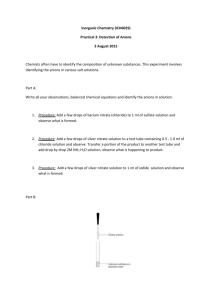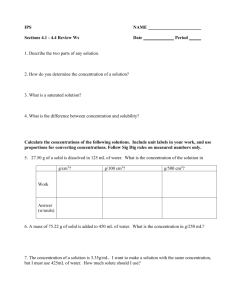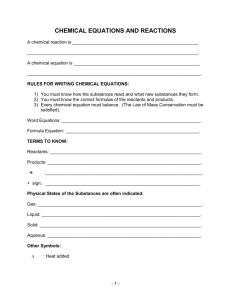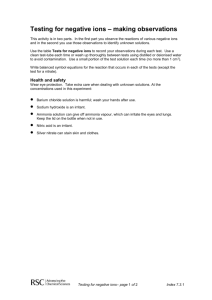Double Displacement
advertisement
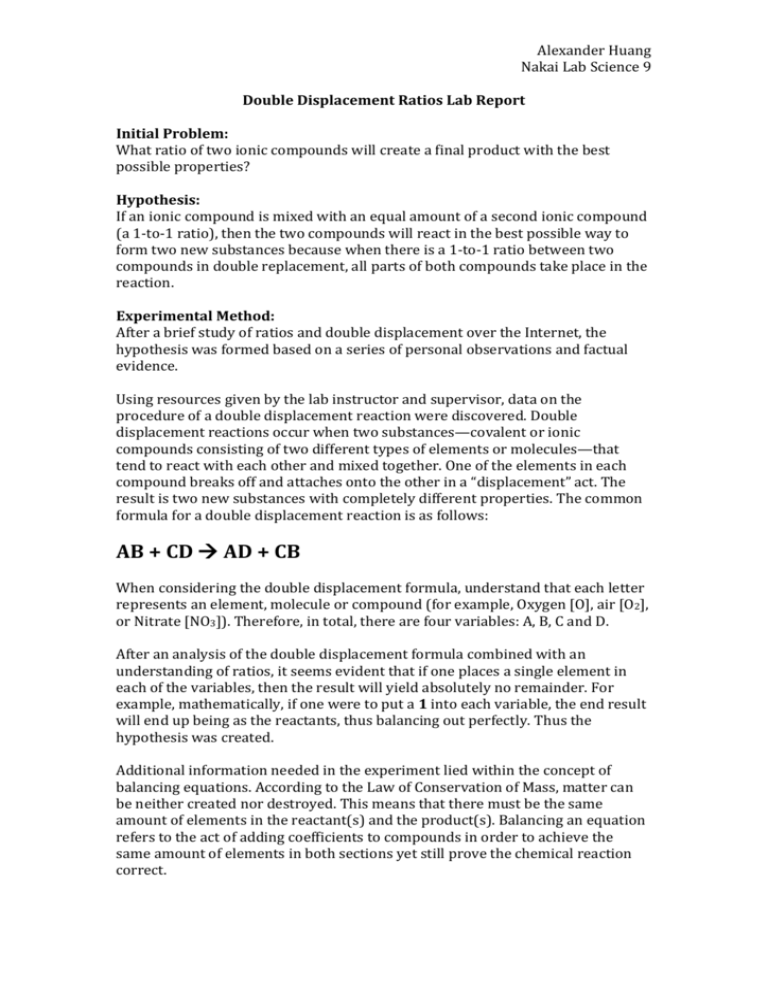
Alexander Huang Nakai Lab Science 9 Double Displacement Ratios Lab Report Initial Problem: What ratio of two ionic compounds will create a final product with the best possible properties? Hypothesis: If an ionic compound is mixed with an equal amount of a second ionic compound (a 1-to-1 ratio), then the two compounds will react in the best possible way to form two new substances because when there is a 1-to-1 ratio between two compounds in double replacement, all parts of both compounds take place in the reaction. Experimental Method: After a brief study of ratios and double displacement over the Internet, the hypothesis was formed based on a series of personal observations and factual evidence. Using resources given by the lab instructor and supervisor, data on the procedure of a double displacement reaction were discovered. Double displacement reactions occur when two substances—covalent or ionic compounds consisting of two different types of elements or molecules—that tend to react with each other and mixed together. One of the elements in each compound breaks off and attaches onto the other in a “displacement” act. The result is two new substances with completely different properties. The common formula for a double displacement reaction is as follows: AB + CD AD + CB When considering the double displacement formula, understand that each letter represents an element, molecule or compound (for example, Oxygen [O], air [O2], or Nitrate [NO3]). Therefore, in total, there are four variables: A, B, C and D. After an analysis of the double displacement formula combined with an understanding of ratios, it seems evident that if one places a single element in each of the variables, then the result will yield absolutely no remainder. For example, mathematically, if one were to put a 1 into each variable, the end result will end up being as the reactants, thus balancing out perfectly. Thus the hypothesis was created. Additional information needed in the experiment lied within the concept of balancing equations. According to the Law of Conservation of Mass, matter can be neither created nor destroyed. This means that there must be the same amount of elements in the reactant(s) and the product(s). Balancing an equation refers to the act of adding coefficients to compounds in order to achieve the same amount of elements in both sections yet still prove the chemical reaction correct. Alexander Huang Nakai Lab Science 9 The lab experiment will involve two sub-experiments between two ionic compounds: Calcium Nitrate and Sodium Oxalate, and Lead Nitrate and Sodium Iodide. In the hypothesis and the overall experiment, the ratio is the independent variable, and the reaction is the dependent variable. This indicates that during the experiment, the ratio will be changing the result of the reaction (if there is a change). The control of this experiment is each of the four compounds by Calcium Nitrate before Sodium Oxalate was added to the themselves. Each control experiment. It looks just like water from this point of view. had about the same chemical properties from human perspective; they each had generally a clear color, it had no odor, and it was at room temperature. It is important to know what the original properties of the substance looks like when determining the effectiveness of a chemical reaction, so controls are used. Due to conservation purposes, the controls were not dropped directly into any well. In order to prove that a chemical reaction indeed occurred when two of the above compounds mixed together, a basic “Evidence for Chemical Reactions” list was used in conjunction with the experiment. The list is as follows: Evidence for Chemical Reactions A gas is released. An insoluble substance is produced. A permanent color change is observed. A heat energy change is noted. (exothermic reaction: releases heat) (endothermic reaction: absorbs heat) (Light is emitted) Before the experiment, is it expected that each experimenter should equip themselves with safety goggles and aprons in order to ensure well-being during the experiment (should anything go wrong). It would also be wise to understand the chemical formula of each compound: Calcium Nitrate: Ca(NO3)2 Sodium Oxalate: Na2C2O4 Lead Nitrate: Pb(N3)2 Sodium Iodide: NaI Alexander Huang Nakai Lab Science 9 As said above, the experiment will be composed of two parts: the mixing of Calcium Nitrate and Sodium Oxalate, and the mixing of Lead Nitrate and Sodium Iodide. During the experiment, four drops of demineralized water will be placed into nine different wells. Then, one compound (so, in the first experiment, Calcium Nitrate) is dropped using a pipette from left to right, with one drop into the first well, two drops into the second well, continuing in this fashion until nine drops are dropped into the 9th well. Then, the second compound (following Calcium Nitrate, Sodium Oxalate) will follow the same dropping pattern as the first compound, except that it will be dropped in reverse order (meaning one drop in the 9th well, two drops in the 8th well, etc). The ending result will be nine different wells with nine different ratios of the two compounds. Procedure: The above image was taken directly from the official experiment sheet. Please note that the experiment requires only one sheet of white paper and one sheet of black paper, but nine toothpicks (for best results). There needs to be a minimum of seventy-four drops of water (a 250mL bottle of de-mineralized water would be more than enough). The procedure is as follows: 1. Take the black sheet of paper and place it on the lab table. Place the 96well micro plate on top of the black paper. 2. Add four drops of de-mineralized water to the first row’s nine wells using a pipette. 3. Using a second pipette, take one drop of Calcium Nitrate and add it to the first well (1A). Then add two drops of Calcium Nitrate to Well 2, three to Well 3 and so on until you add nine drops to Well 9. 4. With a third pipette, use the same manner to add drops of Sodium Oxalate into wells, except in reverse order. That means one drop of Sodium Oxalate into Well 9, two drops in Well 8 and so on until you add nine drops to Well 1. 5. Mix each of the wells with a toothpick (for best results use one toothpick per well, so no excess molecules are added to any well). 6. While waiting for the reaction to complete, make a table of the ratios from each of the wells (1:9 for the first well, 2:8 for the second, etc). Alexander Huang Nakai Lab Science 9 7. After five minutes, examine wells. Write observations and evidence for each ratio. 8. Make a table of the ratios, the observations and the evidence for Calcium Nitrate and Sodium Oxalate. 9. Balance the reaction, which is Ca(NO3)2 + Na2Ca2O4 CaC2O4 + NaNO3 and keep note of the ratio of the coefficients of the balanced equation. The procedure for the second experiment (the one with Lead Nitrate and Sodium Iodide) is very similar: 10. Take the white sheet of paper and place it on the table. Place the 96-well micro plate on top of the white paper. 11. Add four drops of de-mineralized water to the second row’s nine wells with a clean pipette. 12. Using a second pipette, take one drop of Lead Nitrate and add it to the first well (1B). Use the pattern in Step 3 above; add one drop of Lead Nitrate to the first well, two to the second, and so on until nine drops are added to Well 9. 13. With the third pipette, take a drop of Sodium Iodide and add it to Well 9. Follow the pattern in Step 4; add one drop of Sodium Iodide to the ninth well, two to eighth, and so on until nine drops are added to the first well. 14. Write observations and evidence for each of the ratios in the second experiment. 15. Make a table of ratios, observations and evidence for Lead Nitrate and Sodium Iodide. 16. Balance the reaction, which is Pb(N3)2 + NaI PbI2 + NaNO3, and keep note of the ratio of the coefficients of the balanced equation. No stirring is needed for the second experiment, but waiting a while for the reaction to complete is suggested. Alexander Huang Nakai Lab Science 9 Data Collection In the above table, the different ratios of each well are shown, with observations in the “Evidence” section and conclusions in the “Observations” section. Take note that in each ratio, the first number refers to the drops of Calcium Nitrate in the overall compound, while the second number refers to the number of drops of Sodium Oxalate. According to the graph, it appears that the properties of the substance remain exactly the same – every well was cohesive, milky white, and foggy, with a precipitate formed and its temperature colder than the reactants. The only noticeable difference between each ratio is each property’s intensity within the substance. The equation Ca(NO3)2 + The results of Calcium Nitrate and Sodium Oxalate – milky, foggy substances that do not fall when flipped upside down – just like the Dairy Queen™ Blizzard! Alexander Huang Nakai Lab Science 9 Na2Ca2O4 CaC2O4 + NaNO3 could be balanced out by simply adding the coefficient “2” after NaNO3. With that coefficient in place, the equation abides by the Law of Conservation of Mass. For the ratios of the second table, the first number is the number of drops of Lead Nitrate into a given well, while the second drop is the number of drops of Sodium Iodide into a given well. Much like the first experiment, the properties of each ratio was not different, but in different intensities. As seen in the photo, each substance is yellow, opaque, and cohesive, but the tone of each yellow is slightly different depending on its ratio. For the balancing of the second equation (Pb(NO3)2 + NaI PbI2 + NaNO3), it was discovered that there needs to be a coefficient in front of NaI and NaNO3 to abide by the Law of Conservation of Mass. The result of the mixing of Lead Nitrate and Sodium Iodide in the second row of the microplate (the first row still containing the first experiment). Looks like this is how they make LEGO™s. Alexander Huang Nakai Lab Science 9 Data Processing It is absolutely vital to remember the overall aim of the experiment while processing the data. The experiment’s purpose is to see which ratio of ionic compounds will create the most complete reaction in the double displacement reaction. The experiment is more about observations, patterns and ratios than exact numbers, trends and other mathematical equations. According to the Evidence for Chemical Reactions list, a reaction has occurred within all wells of the first experiment because the color has been changed, a temperature change is apparent, and a precipitate was formed (not shown in the image). It is evident that all properties remain the same. However, as said in the description of the table, each ratio of the experiment had a different intensity of the reaction. For now, it is believed that the biggest reaction is the most complete reaction, because it made the most out of it with the same number of drops (each well had a total of ten drops in it). Looking at the observations made during the experiment and the image of the experiment itself, it is apparent that the middle three wells (the 4:6 ratio, 5:5 ratio, and 6:4 ratio, or wells 4, 5 and 6) are the milkiest and foggiest. However, in well #5 (5:5 ratio), the substance is so foggy to the point of nearly being opaque; thus, from the naked eye, the ratio 5:5 – which can be simplified to a 1:1 ratio – is the most complete reaction. This assumption can be confirmed by looking into the double displacement equation of Calcium Nitrate and Sodium Oxalate. The double displacement formula for Calcium Nitrate and Sodium Oxalate is given: Ca(NO3)2 + Na2Ca2O4 CaC2O4 + NaNO3. During the experiment, it was discovered by adding the coefficient “2” in front of NaNO3, the equation would be balanced. Thus the ratio of the first experiment is 1:1 1:2. A 1:1 ratio is the closest ratio to match this balanced equation. The second experiment is a chemical reaction because of a permanent color change. The change in color is considered a chemical change in this experiment because it is difficult to mix two clear substances together and physically obtain a yellow color. The result of the Lead Nitrate and Sodium Iodide experiment is very much like the result of the Calcium Nitrate and Sodium Oxalate one. It’s a bit difficult to see it in the image, but the 5:5 ratio (5th well) has the darkest tone of yellow among the others. The chemical equation for Lead Nitrate and Sodium Iodide (Pb(NO3)2 + NaI PbI2 + NaNO3) is balanced by adding the coefficient 2 in front of NaI and NaNO3. This makes the ratio of the second experiment 1:2 1:2. This shows that the total amount of molecules in the experiment (each number is a molecule) Alexander Huang Nakai Lab Science 9 remains the same (3), meaning that if a 1:1 ratio were to occur, it would close to a perfect reaction. Evaluation The hypothesis is proven correct because in both sub-experiments, the 1-to-1 ratios had the best reaction among all nine ratios. The original hypothesis of the experiment was that if there were equal amounts of drops from both ionic compounds in a double displacement experiment, then the reaction would yield the biggest and best results. According to the data taken from the experiment, the 1-to-1 ratio had the most intense change in properties (see Tables 1 and 2, ratio 5:5). The processed results of the experiment also seem to show that among all nine possible ratios, the 1-to-1 ratio yields the best reaction. This assumption is proven by the balancing of equations and the discovery of the ratios of the coefficients in each formula. The results of the experiment and the processed data both prove the hypothesis correct. It seems straightforward to assume that one drop of a substance will mix with exactly another drop of a second substance, and the balancing of the equation proves it. In the first Calcium Nitrate and Sodium Oxalate experiment, a 1:1 ratio creates the perfect reaction, as there is one drop of both compounds mix together perfectly to form three molecules. In the second experiment, there is a 1:2 ratio, which would roughly translate to a 3.33:6.67 reaction (out of 10 drops). The closest to achieve this “perfect” ratio as a whole number still lies within the 1:1 threshold. Thus, it is safe to conclude that a 1:1 ratio would generally give the best reaction. Some of the mistakes that have been made during the experiment was that the procedure was done only once, the pipettes were not thoroughly cleaned, and the wells were not all stirred properly. The procedure’s results were quite similar in properties; it took close observations to tell a difference. Perhaps this is the general case in the experiment, but verification would be ideal. In addition, the pipettes were not thoroughly cleaned after the first experiment was completed, meaning that excess Calcium Nitrate, Sodium Oxalate or water molecules may have altered the second experiment. Lastly, it took around thirty seconds to one minute before one experimenter discovered the failure to stir each well with a toothpick. This could have resulted in some errors in data collection. The design of the experiment could have been a lot more organized and wellconstructed. Some of the mistakes made during the experiment could easily have been avoided, such as properly cleaning the pipettes between each experiment. The 96-well microplate has eight rows; with these eight rows, it is possible to conduct eight experiments, or a maximum of four recreations. The experiment could also have been expanded to a total of eleven drops instead of nine. The understanding of double displacement reactions and ratios flourished during and after experiment. It allowed experimenters to learn the art of Alexander Huang Nakai Lab Science 9 balancing equations, the idea of double displacement reactions, and the implementation of ratios into science.



